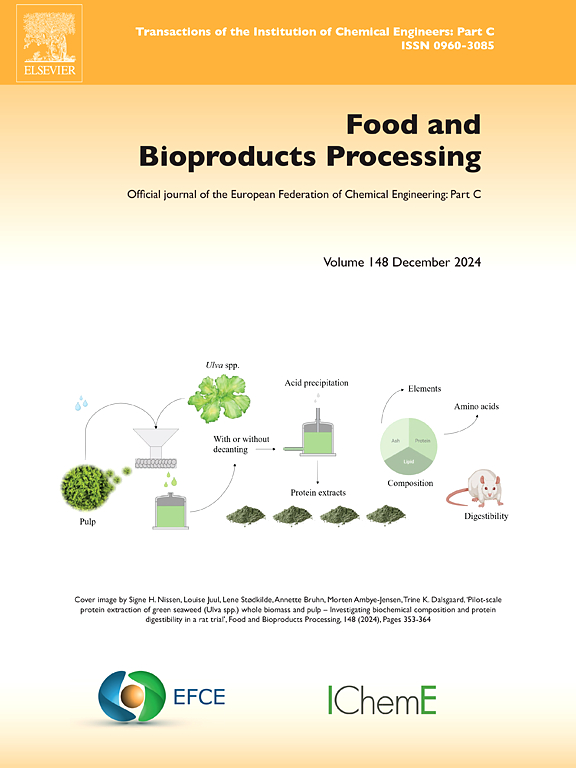Tailoring anthocyanin stability with pea–rice proteins and fructooligosaccharides: A microencapsulation study using double emulsion
IF 3.4
2区 农林科学
Q2 BIOTECHNOLOGY & APPLIED MICROBIOLOGY
引用次数: 0
Abstract
This study investigated the impact of plant protein matrix composition and fructooligosaccharide (FOS) concentration on the microencapsulation performance of black carrot anthocyanins. Nine formulations were developed using pea, rice, and their blends with varying FOS levels (0–1 %). The combination of pea–rice protein with 1 % FOS (T9) demonstrated optimal performance, exhibiting the highest color retention (L* = 76.06, a = 21.23, b* = −4.92), enhanced solubility in simulated gastric and intestinal fluids (76.19 % and 80.79 %, respectively), and extended anthocyanin half-life (t₁/₂ = 364.8 days). Fourier transform infrared (FT-IR) spectroscopy revealed that FOS altered the secondary structure of proteins, promoting the formation of β-turns and β-sheets, which contributed to improved matrix density and pigment stability. Particle size analysis showed that FOS-containing samples generally produced smaller, more uniform microcapsules, supporting enhanced bioavailability. Controlled gastrointestinal release profiles further confirmed the functional role of FOS, with T9 achieving 50.34 % anthocyanin release in the intestinal phase while minimizing premature release. These findings highlight the synergistic potential of plant protein–FOS systems for protecting anthocyanins during processing and digestion. The results support their application in functional foods and nutraceutical formulations, offering improved stability, controlled release, and targeted delivery. In conclusion, incorporating FOS into plant protein-based microcapsules (especially a pea–rice protein blend) markedly enhanced anthocyanin stability and targeted intestinal release, demonstrating the effectiveness of this encapsulation strategy for functional food applications. Future research should explore real-food integration, in vivo validation, and process scalability to unlock their full potential.
豆米蛋白和低聚果糖裁剪花青素稳定性:双乳微胶囊化研究
研究了植物蛋白基质组成和低聚果糖(FOS)浓度对黑胡萝卜花青素微胶囊化性能的影响。用不同FOS水平(0-1 %)的豌豆、水稻及其混合物开发了9种配方。豌豆-大米蛋白与1 % FOS (T9)的组合表现出最佳的性能,具有最高的保色性(L* = 76.06, a = 21.23, b* = - 4.92),增强了在模拟胃液和肠液中的溶解度(分别为76.19 %和80.79 %),延长了花青素半衰期(t₁/ 2 = 364.8天)。傅里叶红外(FT-IR)光谱分析表明,FOS改变了蛋白质的二级结构,促进了β-turn和β-sheets的形成,从而提高了基质密度和色素的稳定性。粒度分析表明,含有fos的样品通常产生更小、更均匀的微胶囊,支持提高生物利用度。控制胃肠道释放曲线进一步证实了FOS的功能作用,T9在肠道期花青素释放达到50.34 %,同时最大限度地减少了过早释放。这些发现强调了植物蛋白- fos系统在加工和消化过程中保护花青素的协同潜力。结果支持其在功能食品和营养保健品配方中的应用,提供更好的稳定性,控释和靶向给药。综上所述,将FOS加入植物蛋白微胶囊(尤其是豌豆-大米蛋白混合物)可显著提高花青素的稳定性和靶向肠道释放,证明了这种胶囊化策略在功能食品应用中的有效性。未来的研究应该探索真正的食品整合、体内验证和工艺可扩展性,以释放它们的全部潜力。
本文章由计算机程序翻译,如有差异,请以英文原文为准。
求助全文
约1分钟内获得全文
求助全文
来源期刊

Food and Bioproducts Processing
工程技术-工程:化工
CiteScore
9.70
自引率
4.30%
发文量
115
审稿时长
24 days
期刊介绍:
Official Journal of the European Federation of Chemical Engineering:
Part C
FBP aims to be the principal international journal for publication of high quality, original papers in the branches of engineering and science dedicated to the safe processing of biological products. It is the only journal to exploit the synergy between biotechnology, bioprocessing and food engineering.
Papers showing how research results can be used in engineering design, and accounts of experimental or theoretical research work bringing new perspectives to established principles, highlighting unsolved problems or indicating directions for future research, are particularly welcome. Contributions that deal with new developments in equipment or processes and that can be given quantitative expression are encouraged. The journal is especially interested in papers that extend the boundaries of food and bioproducts processing.
The journal has a strong emphasis on the interface between engineering and food or bioproducts. Papers that are not likely to be published are those:
• Primarily concerned with food formulation
• That use experimental design techniques to obtain response surfaces but gain little insight from them
• That are empirical and ignore established mechanistic models, e.g., empirical drying curves
• That are primarily concerned about sensory evaluation and colour
• Concern the extraction, encapsulation and/or antioxidant activity of a specific biological material without providing insight that could be applied to a similar but different material,
• Containing only chemical analyses of biological materials.
 求助内容:
求助内容: 应助结果提醒方式:
应助结果提醒方式:


